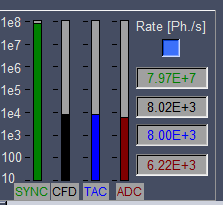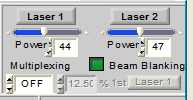Most laser scanning systems such as B&H DCS-120, Zeiss LSM series (710, 780, 880, 980), Leica (SP5, SP8), Nikon (A1, C1, C2) use laser beam blanking. Beam blanking blocks the laser light emission during fly back periods (line flyback and frame flyback), i.e. periods which do not contribute directly to the image creation. In many cased of laser scanning based FLIM beam blacking leads to a display of variable SYNC rate in the SPCM software. This is disappointing to many users but is usually the correct behavior.

On Becker & Hickl DCS-120 scanning system the beam blacking functionally is switched ON and OFF in the GVD-120 control panel. By default this beam blacking should enabled.

On Zeiss LSMs beam blacking is always on. On such systems with 1p excitation by picosecond pulsed lasers the laser is switched ON and OFF periodically. If the laser is OFF there is also no SYNC signal created by the laser because it is not pulsing. Consequently, the SYNC counter on the TCSPC module sometimes “sees” a SYNC signal (during regular imaging) and sometimes it “sees” no SYNC signal (during flyback). As a result of this ON/OFF procedure the display SYNC rate is lower than the actual repetition rate of the laser. So, beam blacking leads to a display of variable SYNC rate.
Example: if the laser is set to a repetition rate of 50 MHz the laser will emit 50 million pulses per second during the ON period and none during the OFF period. The SYNC counter will display a SYNC rate which will be lower than 50 MHz (5e7); in some case the display can be as low as 25 MHz.
On multi-photon systems with 2p excitation by a femtosecond laser, i.e. DCS-120 MP, Zeiss NLO LSMs, Jenlab MPTflex, etc. , the SYNC rate is constant and usually around 80 MHz (8e7). On these system the laser is not switched off. If a beam blacking feature is present it is usually an optical beam blanking by an AOM or a Pockels cell.
